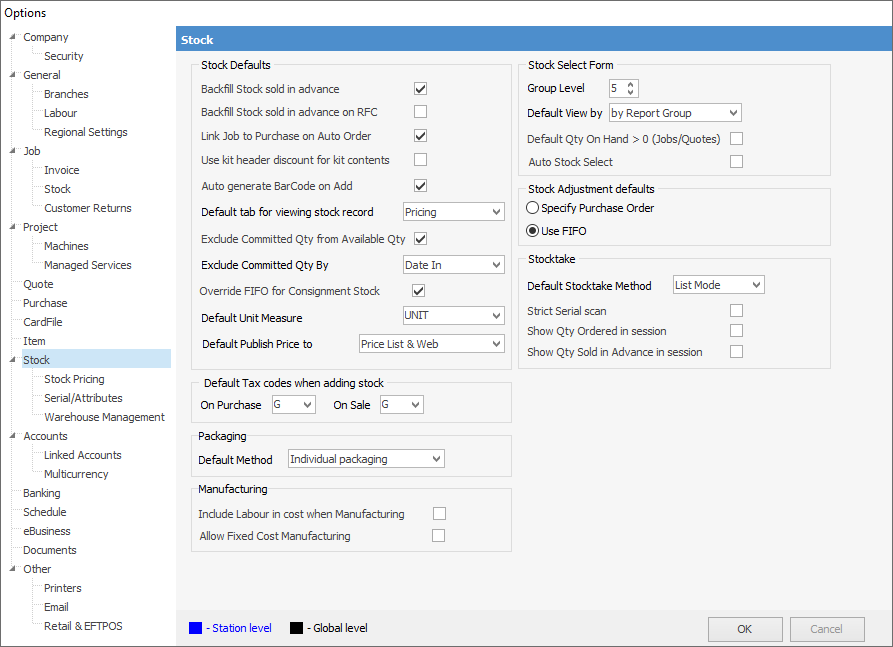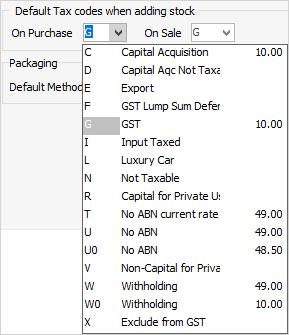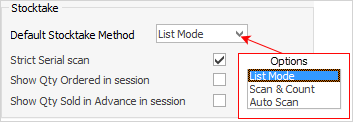
On the ribbon, go to Tools > Options > Stock.

There are important and specific stock default areas set here. Each impacts globally on the function of stock, ie. every user accessing stock is affected by the options set here. The significance of each is described below. These options are designed to increase accuracy when pricing stock, and reduce user input. These options impact on the calculation of prices and tax within Jim2.
Field |
Explanation |
||||||||||||
Backfill Stock sold in advance |
If selected, the Backfill Stock Sold in Advance option will automatically backfill any stock that has been sold in advance, using stock being received on purchases, stock adjustments up, stock transferred from another location, and stock that has been unallocated from jobs. This can be overridden at a stock level, allowing that a specific stock is not to be backfilled, for example. |
||||||||||||
Backfill Stock sold in advance on RFC |
If this option is ticked, when you finish a return from customer and there is any of that stock sold in advance, it will automatically backfill those transactions. This would normally not be ticked for reasons like you wish to do an RTV, or you simply want to fix an incorrect price. |
||||||||||||
Link Job to Purchase on Auto Order |
This option allows you to choose whether to link jobs and POs by default when using the Auto Create PO functionality. If your business has a high volume of specific orders for jobs, you would select this option to track the stock and ensure it is supplied to the correct customer when it is received. |
||||||||||||
Auto Stock Select |
If you tick this option, when you type a stock code in the stock grid on jobs it will take you to that stock record in the Stock Select screen when you press Enter (or Tab). If the option is not ticked, when you enter a stock code and press Enter, the cursor will move across to the Description field. |
||||||||||||
Use kit header discount for kit contents |
If you tick this option, when you add a discount to a kit header, the same discount will automatically be reflected on the individual stock lines within the kit.
 |
||||||||||||
Auto generate BarCode on Add |
If you tick this option, whenever you add a new stock record a barcode will automatically be generated for that stock.

|
||||||||||||
Default tab for viewing stock record |
When opening a stock record, you have two choices as to which tab you would like to default to view – either the record (transactions) or selling (pricing and costing information). The options are: Pricing, Stock on Hand, Stats, Buying, Vendors and Transactions. |
||||||||||||
Exclude Committed Qty from Available Qty |
Committed Qty is defined as the supplied quantity plus the back ordered quantity. If this option is selected, any stock allocated to jobs is effectively reserved, and therefore unavailable. A sales company would typically select this option, whereas a service-oriented company may require more flexibility. For example, I have a hard drive allocated to a job, but the job cannot be completed as it is waiting for other parts – I need to use this hard drive on a different job that can be completed now.
If Exclude Committed Qty from Available Qty is ticked, Auto Pick on job list will consider all jobs in date due/in order when allocating stock to jobs. When entering ordered or supplied quantity into jobs when Exclude Committed Qty from Available Qty is ticked, if the stock is not available the Stock Availability screen will display. If the user has ticked Allow to sell committed stock, an extra option will be available: Sell committed stock. The user must select Sell committed stock or Supply in advance to be able to enter an amount greater than the amount available into the supplied quantity column, for example:
|
||||||||||||
Exclude Committed Qty By |
Here, you can select either Date Due or Date In. Date In is the date the job was added to Jim2. Date Due can be determined according to the customer requirements. This allows you to decide whether to use already committed stock (on another job) that could be replaced before it’s required.
This option is only available if Exclude Committed Qty from Available Qty is ticked. |
||||||||||||
Override FIFO for Consignment stock |
If you have consignment stock, this option allows you to override using the FIFO (first in first out) method, if you would prefer to use what you already have in stock first. This is not recommended to be ticked as it can have Profit & Loss consequences. |
||||||||||||
Default Unit Measure |
This section allows you to choose your default unit of measure, ie. unit, each, etc. when adding new stock records. |
||||||||||||
Default Publish Price to |

Here you can decide whether you want to push prices up to your website or not. Choose from: ▪Price List & Web ▪Price List ▪Web ▪Don't Publish |
||||||||||||
Default Tax Codes when adding stock |

When adding new stock to Jim2, you will need to specify the default tax codes for purchase and sale of that stock. Within this screen you can select the tax codes most commonly used in purchase and sale of stock as the default. This means, when you are adding new stock to Jim2, it will automatically show these defaults. For example, in Australia GST is currently legislated to be 10%. This is the normal (default) tax – use that code for both purchase and sale of stock. |
||||||||||||
Packaging Default Method |

The choices are Individual packaging or Batch packaging. Individual packaging will create one package at a time. Batch packaging will create all packages at once. Note that, if there are serial numbers required, you must package individually to ensure the correct serial numbers are used. |
||||||||||||
Manufacturing |

Select either or both of these settings. See Manufacturing Jobs for more information.
Fixed cost manufacturing is multi-level manufacturing. |
||||||||||||
Stock Select Form |

Group Level sets the default Group Level (0 – 5) for the Stock Select form.
Default View by: select by Report Group or by Brand (non report group) for the Stock Select form.
Default Qty On Hand > 0 (Jobs/Quotes): when selecting stock on a job, this allows you to only see stock on hand greater than zero. |
||||||||||||
Stock Adjustment Details |

This allows you to choose to use either the actual purchase order number or the FIFO method for selecting stock on stock adjustments.
|
||||||||||||
Stocktake |

For more details, see Stocktake. |
Further information:
